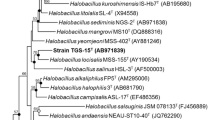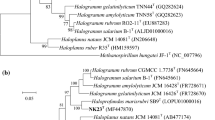Abstract
Three pigmented strains of halophilic archaea, RS94-RS96, were isolated from acidic foamy products of flotation enrichment of potassium minerals (Silvinit Co., Solikamsk, Russia). The cells were gram-negative, nonmotile, pleomorphic ovoids, 1.0−1.5 × 1.5−2.5 μm. The isolates were chemoorganotrophic, obligately aerobic, and catalase-positive. A range of carbohydrates and organic acids was used, as well as amino acids and peptides. The strains were halophiles and thermotolerant neutrophiles. They grew in the media with 15 to 30% NaCl (optimum at 20–22%) and 0.005–0.7 M Mg2+ (0.1–0.2 M), at pH 5.0–8.2 (optimum 7.0–7.2) and 25–55°C (optimum at 35–50°C). The major fatty acids were C16:0, C18:1, C18:0, and C16:1. The membranes contained carotenoid pigments of the bacterioruberin series and polar lipids, mostly as C20,C20 isoprenoid derivates: phosphatidylglyceromethylphosphate, phosphatidylglycerol, and three unidentified sulfated glycolipids of the S-DGD type. The DNA G+C content was 65.1–66.4 mol %. Phylogenetic analysis based on the 16S rRNA gene sequencing revealed that the thermotolerant neutrophilic isolate RS94 (DNA G+C content of 66.4 mol %) was most closely related to the nonpigmented moderate acidophile Halarchaeum acidiphilum MH1-52-1T (97.3%). Based on its phenotypic and genotypic characteristics, the organism was classified as a new species of the genus Halarchaeum with the proposed name Halarchaeum solikamskense sp. nov. The type strain is RS94T (= VKPM B-11282T).
Similar content being viewed by others
References
Grant, W.D., Kamekura, M., McGenity, T.J., and Ventosa, A., Order I. Halobacteriales, in Bergey’s Manual of Systematic Bacteriology, 2nd ed., Boone, D.R., Castenholz, R.W., and Garritty, G.M., Eds., New York: Springer, 2001, vol. 1, pp. 294–334.
Wain-, M., Tindall, B.J., and Ingvorsen, K., Halorhabdus uthahensis gen. nov., sp. nov., an Aerobic, Extremely Halophilic Member of the Archaeae from Great Salt Lake, Utah, Int. J. Syst. Evol. Microbiol., 2000, vol. 50, pp. 183–190.
Oren, A., Elevi, R., Watanabe, S., Ihara, K., and Corcelli, A., Halomicrobium mukohataei gen. nov., comb. nov., and Emended Description of Halomicrobium mukohataei, Int. J. Syst. Evol. Microbiol., 2002, vol. 52, pp. 1831–1835.
Hezayen, F.F., Tindall, B.J., Steinbüchel, A., and Rehm, B.H.A., Characterization of a Novel Halophilic Archaeon, Halobiforma haloterrestris gen. nov., sp. nov., and Transfer Natronobacterium nitratireducens to Halobiforma nitratireducens comb. nov., Int. J. Syst. Evol. Microbiol., 2002, vol. 52, pp. 2271–2280.
Vreeland, R.H., Straight, S., Krammes, J., Dougherty, K., Rosenzweig, W.D., and Kamekura, M., Halosimplex carlsbadense gen. nov., sp. nov., a Unique Halophilic Archaeon, with Three 16S rRNA Genes, that Grows Only in Defined Medium with Glycerol and Acetate or Pyruvate, Extremophiles, 2002, vol. 6, pp. 445–452.
Itoh, T., Yamaguchi, T., Zhou, P., and Takashina, T., Natronolimnobius baerhuensis gen. nov., sp. nov. and Natronolimnobius innermongolicus sp. nov., Novel Haloalkaliphilic Archaea Isolated from Soda Lakes in Inner Mongolia, China, Extremophiles, 2005, vol. 9, pp. 111–116.
Xue, Y., Fan, H., Ventosa, A., Grant, W.D., Jones, B.E., Cowan, D.A., and Ma, Y., Halalkalicoccus tibetensis gen. nov., sp. nov., Representing a Novel Genus of Haloalkaliphilic Archaea, Int. J. Syst. Evol. Microbiol., 2005, vol. 55, pp. 2501–2505.
Castillo, A.M., Gutiérrez, M.C., Kamekura, M., Ma, Y., Cowan, D.A., Jones, B.E., Grant, W.D., and Ventosa, A., Halovivax asiaticus gen nov., sp. nov., a Novel Extremely, Halophilic Archaeon Isolated from Inner Mongolia, China, Int. J. Syst. Evol. Microbiol., 2006, vol. 56, pp. 765–770.
Castillo, A.M., Gutiérrez, M.C., Kamekura, M., Ma, Y., Cowan, D.A., Jones, B.E., Grant, W.D., and Ventosa, A., Halostagnicola larsenii gen. nov., sp. nov., an Extremely Halophilic Archaeon from a Saline Lake in Inner Mongolia, China, Int. J. Syst. Evol. Microbiol., 2006, vol. 56, pp. 1515–1517.
Savege, K.N., Krumholz, L.R., Oren, A., and Elshahed, M.S., Haladaptatus paucihalophilus gen. nov., sp. nov. a Halophilic Archaeon Isolated from a Low-Salt, Sulfide-Rich Spring, Int. J. Syst. Evol. Microbiol., 2007, vol. 57, pp. 19–24.
Burns, D.G., Janssen, P.H., Itoh, T., Kamekura, M., Li, Z., Jensen, G., Rodriguez-Valera, F., Bolhius, H., and Dyall-Smith, M.L., Haloquadratum walsbyi gen. nov., sp. nov., the Square Haloarchaeon of Walsby, Isolated from Saltern Crystallizers in Australia and Spain, Int. J. Syst. Evol. Microbiol., 2007, vol. 57, pp. 387–392.
Bardavid, R.E., Mana, L., and Oren, A., Haloplanus natans gen. nov., sp. nov. an Extremely Halophilic, Gas-Vacuolate Archaeon Isolated from Dead Sea-Red Sea Water Mixtures in Experimental Outdoor Ponds, Int. J. Syst. Evol. Microbiol., 2007, vol. 57, pp. 780–783.
Gutiérrez, M.C., Castillo, A.M., Kamekura, M., Xue, Y., Ma, Y., Cowan, D.A., Jones, B.E., Grant, W.D., and Ventosa, A., Halopiger xanaduensis gen nov., sp. nov., an Extremely Halophilic Archaeon Isolated from Saline Lake Shangmatala in Inner Mongolia, China, Int. J. Syst. Evol. Microbiol., 2007, vol. 57, pp. 1402–1407.
Savege, K.N., Krumholz, L.R., Oren, A., and Elshahed, M.S., Halosarcina palluda gen. nov., sp. nov., Halophilic Archaeon from a Low-Salt, Sulfide-Rich Sping, Int. J. Syst. Evol. Microbiol., 2008, vol. 58, pp. 856–860.
Minegishi, H., Echigo, A., Nagaoka, S., Kamekura, M., and Usami, R., Halarchaeum acidiphilum gen. nov., sp. nov., a Moderately Acidiphilic Halarchaeon Isolated from Commercial Solar Salt, Int. J. Syst. Evol. Microbiol., 2010, vol. 60, pp. 2513–2516.
Gruber, C., Legat, A., Pfaffenhuemer, M., Radax, C., Weidler, G., Busse, H.-J., and Stan-Lotter, H., Halobacterium noricense sp. nov., an Archaeal Isolate from a Bore Core of Alpine Permian Salt Deposit, Classification of Halobacterium sp. NRC-1 as a Strain of H. salinarum and Emended Description of H. salinarum, Extremophiles, 2004, vol. 8, pp. 431–439.
Yang, Y., Cui, H.-L., Zhou, P.-J., and Liu, S.-J., Halobacterium jilantaiense sp. nov., a Halophilic Archaeon Isolated from a Saline Lake in Inner Mongolia, China, Int. J. Syst. Evol. Microbiol., 2006, vol. 56, pp. 2353–2355.
Yachai, M., Tanasupawat, S., Itoh, T., Benjakul, S., Visessanguan, W., and Valyasevi, R., Halobacterium piscisalsi sp. nov., from Fermented Fish (Pla-Ra) in Thailand, Int. J. Syst. Evol. Microbiol., 2008, vol. 58, pp. 2136–2140.
Saralov, A.I., Kuznetsov, B.B., Reutskikh, E.M., Baslerov, R.V., Panteleeva, A.R., and Suzina, N.E., Arhodomonas recens sp. nov., a Halophilic Alkane-Utilizing Hydrogen-Oxidizing Bacterium from the Brines of Flotation Enrichment of Potassium Minerals, Mikrobiologiya, 2012, vol. 81, no. 5, pp. 582–587.
Kolganova, T.V., Kuznetsov, B.B., and Turova, T.P., Designing and Testing Oligonucleotide Primers for Amplification and Sequencing of Archaeal 16S rRNA Genes, Microbiology, 2002, vol. 71, no. 2, pp. 243–246.
Kushwaha, S.C., Kramer, J.K.G., and Kates, M., Isolation and Characterization of C50 Carotenoid Pigments and Other Polar Isoprenoids from Halobacterium cutirubrum, Biochim. Biophys. Acta, 1975, vol. 398, pp. 303–318.
Takaichi, S., Characterization of Carotenes in a Combination of a C18 HPLC Column with Isocratic Elution and Absorption Spectra with a Photodiode-Array Detector, Photosynth. Res., 2000, vol. 65, pp. 93–99.
Pugh, E.L., Wassef, M.K., and Kates, M., Inhibition of Fatty Acid Synthetase in Halobacterium cutirubrum and Escherichia coli by High Salt Concentration, Can. J. Biochem., 1971, vol. 49, no. 8, pp. 953–958.
Pugh, E.L. and Kates, M., Acylation of Proteins of the Archaebacteria Halobacterium cutirubrum and Methanobacterium thermoautotrophicum, Biochim. Biophys. Acta. Biomembranes, 1994, vol. 1196, no. 1, pp. 38–44.
Author information
Authors and Affiliations
Corresponding author
Additional information
Original Russian Text © A.I. Saralov, R.V. Baslerov, E.M. Reutskikh, B.B. Kuznetsov, 2012, published in Mikrobiologiya, 2012, Vol. 81, No. 5, pp. 638–644.
Rights and permissions
About this article
Cite this article
Saralov, A.I., Baslerov, R.V., Reutskikh, E.M. et al. Halarchaeum solikamskense sp. nov., a thermotolerant neutrophilic haloarchaeon from the foamy products of flotation enrichment of potassium minerals. Microbiology 81, 589–595 (2012). https://doi.org/10.1134/S0026261712050141
Received:
Published:
Issue Date:
DOI: https://doi.org/10.1134/S0026261712050141




